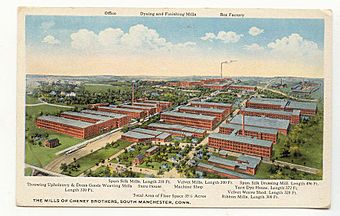Cheney Brothers Historic District facts for kids
|
Cheney Brothers Historic District
|
|

Cheney Brothers Mills, South Manchester, about 1920
|
|
| Location | Manchester, Connecticut |
|---|---|
| Area | 175 acres (71 ha) |
| Built | 1838 |
| Architect | Cheney Bros. Manufacturing Co. |
| Architectural style | Late 19th And 20th Century Revivals, Late Victorian |
| NRHP reference No. | 78002885 |
Quick facts for kids Significant dates |
|
| Added to NRHP | June 2, 1978 |
| Designated NHLD | June 2, 1978 |
The Cheney Brothers Historic District was once a very important place for making silk in Manchester, Connecticut. This area was busy in the late 1800s and early 1900s. It covers about 175 acres (71 hectares).
This special district includes over 275 buildings. You can find old factory buildings, homes where workers lived, churches, schools, and even large houses belonging to the Cheney family. These buildings show us a well-preserved example of a "company town." This means the Cheney Brothers silk company built and owned most of the town. They were the first company in America to successfully raise silkworms and turn their silk into fabric.
The Cheney Brothers company became famous for figuring out how to spin and weave silk. This was a very difficult process back then. Because of its importance, the area was named a National Historic Landmark in 1978.
Contents
What is the Cheney Brothers Historic District?
The Cheney Brothers Historic District is located in South Manchester. It covers a large area of about 175 acres (71 hectares). Imagine a big rectangle on a map. Its edges are roughly Interstate 384 to the south, Fairfield Avenue to the west, and several streets like West, High, Laurel, Forest, and Eldridge to the north. To the east, it's bordered by Chestnut and Spruce Streets.
The main part of the district is a group of sixteen old factory buildings. Most of these buildings are made of brick and were built between 1880 and 1920. They are mostly found along Pine and Elm Streets. Some of these factory buildings are very large!
A Special Company Town
East of the factories, you'll find the beautiful homes of the Cheney family. This area is like a park and has 13 main buildings. The oldest one is the original Cheney Homestead, built in the 1780s. Today, it's a historic house museum run by the Manchester Historical Society. The other Cheney family houses were built over many years, from the early 1800s to the early 1900s.
The Cheney company also built many homes for their workers. These houses are mostly one or two stories tall and made of wood. You can find large groups of them north and west of the factories. There's also a smaller group of worker homes east of the Cheney family mansions.
The Cheney family also built public buildings for the town. These include a large social hall called Cheney Hall, a fire station, and a water treatment plant. They also helped build several schools and churches.
How the Silk Business Started
The Cheney silk business began in the 1830s. At first, they grew mulberry trees. Silkworms eat mulberry leaves. In 1838, they started spinning silk thread near their family home.
However, in 1840, the mulberry market crashed, and many trees got sick. So, the Cheneys decided to focus on spinning silk. By the end of the 1840s, they had become experts at weaving silk fabric. In 1847, Frank Cheney invented a machine that made spinning silk much faster. By the 1860s, the Cheney Brothers were leaders in the silk business all over the world.
Life in the Cheney Town
In South Manchester, the Cheneys practiced something called welfare capitalism. This meant they wanted to create a complete living and working environment for their employees. For example, when they built facilities to improve the water supply for their factories, they also used them to provide water to people's homes. Their electric company also gave power to a much larger area than just the factory.
The company even donated land for churches, schools, and other public places. They truly cared for their workers and the community.
The End of an Era
The Cheney silk business started to slow down in the 1920s. This was because new man-made fibers, like rayon, became popular. The Great Depression in the 1930s also hurt the company a lot. Because of these challenges, the company sold off its utilities and many of its houses.
The Cheney family sold the business in 1954. Today, a much smaller silk operation still runs within the old factory complex.
Legacy of Silk in Manchester
The Cheney Brothers Historic District was named a National Historic Landmark and added to the National Register of Historic Places in 1978. This shows how important it is to American history.
The silk mills had a big impact on the town of Manchester. The city seal even features silk! Also, a local baseball team was named the Manchester Silkworms, showing how proud the town was of its silk heritage.



